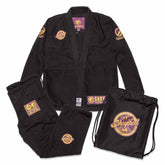Best Body Types for BJJ: Strengths, Weaknesses & Strategy
Brazilian Jiu-Jitsu (BJJ) is one of the few martial arts that truly embraces diversity in body types. BJJ is not like traditional striking arts that often favor specific physiques. BJJ thrives on adaptability. It never matters if you are tall and lean, stocky and strong, or short and agile. There is a unique advantage waiting to be unlocked. But understanding your body type's strengths and weaknesses is the key to crafting a BJJ game that suits you best.
In this detailed guide, we will break down the most common body types in BJJ. We will discuss their pros and cons, and offer strategic advice to help you maximize your performance on the mats. Let’s dive into the science of physicality and grappling.
Understanding the Role of Body Type in BJJ
Brazilian Jiu-Jitsu is often described as “human chess,” and much like chess, the pieces (or in this case, bodies) have different roles. Some players thrive on pressure, some on speed, and others on reach. Understanding your natural advantages allows you to design a game that plays to your strengths.
Here are the five most common body types in BJJ:
- Tall and Lanky
- Short and Stocky
- Athletic and Muscular
- Heavyset or Husky
- Lean and Flexible
Let’s explore each type in detail.
1- Tall and Lanky
Strengths:
- Superior reach for grips, chokes, and guard control
- Advantageous triangle and spider guard setups
- Easier to create distance from opponents
Weaknesses:
- Difficulties in close-quarters scrambling
- Vulnerable to pressure passes and top-heavy opponents
- Longer limbs may be more susceptible to submissions
Best Strategies:
If you are tall and lanky, embrace guard-based games. Triangle chokes, lasso guard, and De La Riva work exceptionally well with long legs. Spider guard allows you to control your opponent’s posture from a distance. Also, develop a strong open guard retention system and work on transitions that give you space, like collar-drags and collar-sleeve attacks.
Key Techniques to Master:
- Triangle choke
- Omoplata
- Lasso guard
- Cross-collar choke from closed guard
2- Short and Stocky
Strengths:
- Naturally lower center of gravity. Thus, making you harder to sweep
- Strong base and explosive movement
- Better control from top positions, especially side control and mount
Weaknesses:
- Limited range for certain submissions like triangle chokes
- Struggles in open guard against lanky opponents
- Difficult to frame against bigger opponents
Best Strategies:
Shorter practitioners shine in top-pressure games. Focus on wrestling entries, pressure passing, and positional control. Guillotines, arm-triangle chokes, and kimuras are effective submission choices. Consider mastering the closed guard with underhook attacks rather than relying on leg-based guards.
Key Techniques to Master:
- Over-under and knee-cut passes
- Guillotine choke
- Arm-triangle choke
- Kimura from side control
3- Athletic and Muscular
Strengths:
- Explosiveness, strength, and fast transitions
- Physical control in scrambles
- High endurance and agility for competition-style BJJ
Weaknesses:
- Risk of over-relying on strength rather than technique
- Slower development of timing-based strategies
- May gas out if pace isn’t managed correctly
Best Strategies:
Use your athleticism to dominate in transitions and scrambles. Combine speed with precision, explosive takedowns, quick guard passes, and seamless positional switches. However, avoid becoming too reliant on strength; technical depth is critical for longevity. Train positional sparring to sharpen your timing and balance your physical gifts with pure skill.
Key Techniques to Master:
- Takedowns (double leg, single leg)
- Toreando pass
- Armbar from mount
- Side-to-side guard passing
4- Heavyset or Husky
Strengths:
- Crushing top pressure
- Extremely difficult to move or sweep
- Natural advantages in mount and north-south control
Weaknesses:
- Limited agility and guard movement
- May tire quicker during prolonged rolls
- Vulnerable to submissions from bottom if not mobile
Best Strategies:
Play a heavy top game and emphasize positional control. Knee-on-belly, mount, and side control should be your bread and butter. Do not neglect cardio. Conditioning makes a massive difference when you are carrying extra weight. Work on improving grip strength and defensive postures so that you can resist submissions and counter with pressure.
Shop BJJ Gi For Big Guys
Key Techniques to Master:
- Smother-style top control
- Americana and keylock
- Kesa-gatame (scarf hold) control
- Knee-on-belly transitions
5- Lean and Flexible
Strengths:
- Excellent guard retention and flexibility-based escapes
- Creative submission chains
- Agile movements and fluid transitions
Weaknesses:
- May lack raw strength for dominant top control
- Struggles against strong pressure players
- Difficulty finishing some submissions without leverage
Best Strategies:
Flexibility is a weapon in modern Jiu-Jitsu. Invert, spin, and flow and create chaos for your opponent. Berimbolos, rubber guard, and tornado guard become highly effective in your hands. However, do not forget to drill core positional escapes and develop strength to supplement your game.
Key Techniques to Master:
- Rubber guard
- Inversion sweeps
- Armbar from guard
- Berimbolo and back takes
Can You Be “Too” Big or “Too” Small for BJJ?
Absolutely not. BJJ is famously welcoming to all body types. Whether you are 5’2” or 6’6”, 120 pounds or 250 pounds, your success lies in adaptation. The art of Jiu-Jitsu teaches you to use what you have and transform it into your advantage. Legendary black belts like Marcelo Garcia, Roger Gracie, and Mikey Musumeci have very different physiques. But all became champions by playing to their strengths.
Building a BJJ Game Plan Around Your Body Type
1- Self-Awareness First
Film your rolls. Observe your balance, mobility, and common pitfalls. Where do you naturally excel, and where do you struggle? Use that as a roadmap.
2- Choose a Guard That Suits You
- Tall & flexible: Spider, lasso, closed, triangle
- Short & stocky: Butterfly, half-guard, closed guard with underhooks
- Heavyset: Half-guard to top control transitions
- Athletic: Open guard with quick entries (X-guard, De La Riva)
3- Train With Different Body Types
Rolling with varied body types forces you to adapt and evolve. You will learn how to counter your weaknesses and refine your game across the board.
4- Conditioning for Body Type
A short, stocky fighter may need more endurance. A lanky player might benefit from grip and core training. A heavier athlete should prioritize cardiovascular and agility training. Build your body to complement your technique.
Final Thoughts: Every Body Can Be a BJJ Body
The best body type for BJJ is not a single, universal mold. But it is your body, used intelligently. With the right strategy, mindset, and dedication, you can craft a dominant Jiu-Jitsu game regardless of your physical makeup.
It does not matter if you are competing or simply training for self-defense and fitness. BJJ offers a lifetime of learning and adaptation. So own your body type. Study its quirks. Build your game around it and you will thrive on the mats like never before.
Shop BJJ Gears From Novakik of any body type


















